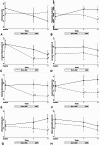Randomized, double-masked, sham-controlled trial of efficacy and safety of quantum molecular resonance for treating meibomian gland dysfunction
- PMID: 40579435
- PMCID: PMC12325607
- DOI: 10.1038/s41433-025-03890-3
Randomized, double-masked, sham-controlled trial of efficacy and safety of quantum molecular resonance for treating meibomian gland dysfunction
Abstract
Background: This randomized, double-blind, sham-controlled trial aimed to evaluate the novel quantum molecular resonance (QMR) device for meibomian gland dysfunction (MGD) treatment.
Methods: Eighty participants diagnosed with MGD were randomized into QMR or sham-QMR groups. Each procedure was performed on days 0, 7, 14, and 21. Primary (meibum quality score) and other secondary outcomes were examined at baseline and weeks 7 and 11. Tear osmolarity and interleukin (IL)-6 and IL-1 receptor agonist levels were evaluated at baseline and week 7. Adverse events were recorded. A multilevel mixed-effect linear regression model was used for data analysis.
Results: Meibum quality (p = 0.008), corneal/conjunctival fluorescein staining score (p = 0.036), telangiectatic vessel area (p = 0.008), and superior (p = 0.011) and inferior (p = 0.020) lid meiboscale were significantly improved in the QMR group than those in the sham-treated group at week 11. Superior lid meiboscale (p = 0.027) and meibomian gland plugging grade (MGPG) (p = 0.017) were significantly improved in the QMR group at week 7. In the QMR group, Ocular Surface Disease Index (OSDI) scores and lid margin thickening grades were significantly lesser at weeks 7 (p = 0.002 and <0.001, respectively) and 11 (both p < 0.001) than the baseline values. At week 7, IL-6 levels were significantly decreased only in the QMR group (p = 0.016). All other parameters did not significantly differ. No serious adverse event occurred.
Conclusions: The QMR device was effective for MGD treatment, with improvements in meibum quality, corneal/conjunctival staining, telangiectatic vessels, MGPG, superior and inferior lid meiboscale, and decreased OSDI score, lid margin thickening grade, and tear IL-6 level.
© 2025. The Author(s).
Conflict of interest statement
Competing interests: None declared.
Figures



Similar articles
-
Safety and efficacy of a novel intense pulsed light system in patients with meibomian gland dysfunction: a randomized, double-masked, intra-individual controlled study.Int Ophthalmol. 2025 Jun 16;45(1):246. doi: 10.1007/s10792-025-03622-2. Int Ophthalmol. 2025. PMID: 40524073 Clinical Trial.
-
One-year outcome of intense pulsed light therapy for refractory meibomian gland dysfunction in patients continuously exposed to topical glaucoma medications: a comparative study.Eye (Lond). 2025 Aug;39(12):2460-2466. doi: 10.1038/s41433-025-03886-z. Epub 2025 Jul 2. Eye (Lond). 2025. PMID: 40604189 Free PMC article.
-
Quantum Molecular Resonance Effects on Patients With Dry Eye Disease: A Randomized Controlled Trial.Cornea. 2024 Sep 1;43(9):1144-1149. doi: 10.1097/ICO.0000000000003443. Epub 2023 Dec 28. Cornea. 2024. PMID: 38166187 Clinical Trial.
-
Lubricating drops for contact lens discomfort in adults.Cochrane Database Syst Rev. 2024 Sep 5;9(9):CD015751. doi: 10.1002/14651858.CD015751.pub2. Cochrane Database Syst Rev. 2024. PMID: 39234924
-
Systemic pharmacological treatments for chronic plaque psoriasis: a network meta-analysis.Cochrane Database Syst Rev. 2021 Apr 19;4(4):CD011535. doi: 10.1002/14651858.CD011535.pub4. Cochrane Database Syst Rev. 2021. Update in: Cochrane Database Syst Rev. 2022 May 23;5:CD011535. doi: 10.1002/14651858.CD011535.pub5. PMID: 33871055 Free PMC article. Updated.
References
-
- Ferrari G, Colucci A, Barbariga M, Ruggeri A, Rama P. High frequency electrotherapy for the treatment of meibomian gland dysfunction. Cornea. 2019;38:1424–9. - PubMed
-
- Pedrotti E, Bosello F, Fasolo A, Frigo AC, Marchesoni I, Ruggeri A, et al. Transcutaneous periorbital electrical stimulation in the treatment of dry eye. Br J Ophthalmol. 2017;101:814–9. - PubMed
Publication types
MeSH terms
Substances
Grants and funding
LinkOut - more resources
Full Text Sources

